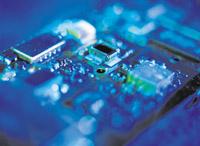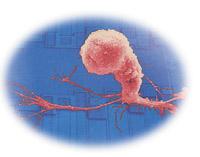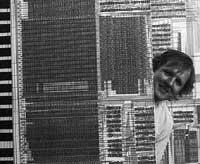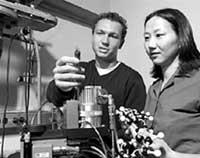Future biological computers
2001/01/01 Azkune Mendia, Iñaki - Elhuyar Fundazioa Iturria: Elhuyar aldizkaria
The challenge of electronics in recent years is to integrate organic matter and biological processes into the functioning of computers. For this purpose they have several reasons. First, the computer aspires to be equivalent to the human brain, but it still has to travel a long way. On the way to electronics it can be said that it is almost to the end and that silicon is at the final limit.

Silica is a basic element for computer micromarketers, but it has begun to show their limitations. The axis of the history of computer science has been miniaturization. The first computers hosted complete rooms and only carried out two operations. Fifty years later, however, the computer is a small compact machine capable of performing a multitude of operations. The basis of this wonder has been the microprocessor. In a few square millimeters of silicon has microscopic transistors, each with its particular work.
In silicon microprocessors the new generations have appeared repeated and the new one has left obsolete the previous one. In 1971, for example, Intel launched the 4004 microprocessor and in 1997 the Pentium II. It should be noted that the second had 3,200 times more transistors than the first. And since then the same trend has been followed.
However, the miniaturization route will soon meet with the physical border. This is because in the integrated circuits the flow of electrons extracts a great heat and requires space for its dispersion. The Pentium III microprocessor, for example, has 9.5 million transistors and all are on a chip of one centimeter in length. All this within the black parallelepiped the size of the eyewear case and whose function is to cool the microprocessor. Without that and without the fan that has behind, the microprocessor would burn nothing more to turn on the computer.
Despite the heat problem, miniaturization requires sophisticated production chains. They must be ten times more sterilized than any operating room in the hospital. Its cost increases exponentially with respect to the speed of microprocessors and within about fifteen years it can be a serious economic barrier.
Organic molecules in the computer

Although by means of microelectronics based on syllins or semiconductors, it will not be possible to perform compact and complex circuits that allow to reach "artificial intelligence". Biological structures are more compact than any silicon system and can respond to the problem. In fact, over the years it has been observed that they have better characteristics than classic electronic components. Currently, molecules with two states (equal to 0 and 1 of binary logic) are synthesized that act similarly to transistors. One of them is the molecule of Errotaxane. It is more surprising the characteristic of other molecules, since in the metallic surface only they are placed in row. This feature would allow to obtain integrated circuits automatically (or naturally).
In the United States, another feature has been found at Yale University. At first the researchers thought that when electrons were circulated by naturally united molecules, some of them, which were conductors, would be degraded rapidly. However, measuring the current circulated in the isolated molecule of benceniditiol with an effective tunnel microscope, it has been possible to verify that a million electrons per second no heat is produced through the molecule in row.
Neurons in the computer
Much has also been advanced with neurons. In 1995, biochemist Peter Fromherz, of the Max Planck Institute, managed to unite neurone and transistor of the plague. The transistor responded to the current supplied by the electrically excited neuron. Then the neurons of the rat and the snail have been used. Lately, however, there has been a conversation between neuron and silica. A part of the chip excites the neuron and another part records the reaction.
Taking into account all these considerations, within about ten years molecular electronics will support silicon components in hybrid computers. But the substitution of semiconductors by biological molecules forces scientists to solve a major problem. These molecules, like any living being, age throughout their life and eventually die. Therefore, the data of these molecular or neuronal machines must be passed to classical memories (magnetooptic) to avoid their loss.
DNA in computers
because DNA is encoded from the four bases, it is used in laboratories as a molecular abacus to solve complex mathematical problems (which cannot solve microcomputers). Because the billions of DNA molecules can react instantly, theoretically the computer made with only DNA would do more operations than uniting all the computers in the world. However, these computers are not useful. For each operation, a specific sequence of chemical reactions should be prepared. It would be like a concrete connection of all internal transistors for each operation on the classic computer.
Therefore, it is considered that the DNA computer, for the moment, is not practical and its enormous computing capacity, will be used for scientific or military needs such as cryptography.

Gai honi buruzko eduki gehiago
Elhuyarrek garatutako teknologia






